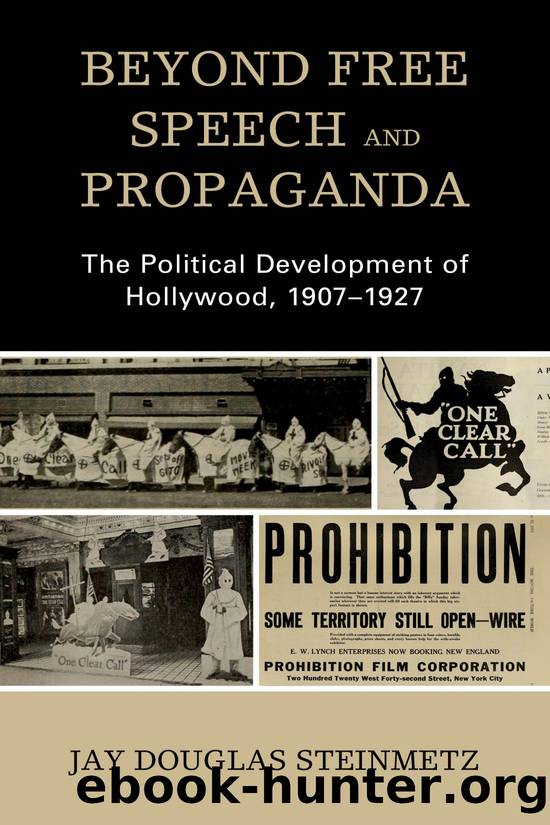Beyond Free Speech and Propaganda by Jay Douglas Steinmetz

Author:Jay Douglas Steinmetz
Language: eng
Format: epub
Publisher: Lexington Books, a division of Rowman & Littlefield Publishers, Inc.
Figure 4.2âScenes from The Yellow Dog. The Moving Picture World, September 21, 1918.
A parade honoring the Yellow Dog detectives was held in Dallas, with more than one thousand members being presented badges by Mayor Joseph E. Lawther and local leaders of the Council of Defense, after which the boys were treated to a free movie at the Old Mill Theatre.41 In Cleveland, another big Yellow Dog parade was held with the cityâs mayor in attendance, this time with help from the Boy Scouts of America and the Red Cross. The Cleveland school board announced cooperation with the campaign, agreeing to write out excerpts of the original Dodge story on chalkboards while encouraging students to see the movie.42 To the movie men, this must have seemed a stunning victoryâthat school teachers and administrators were encouraging students to attend a local motion picture theater would have been unthinkable before the war.
The movie premiered at the Superba Theatre in Los Angeles before a September 29 booking at the Broadway Theatre in New York City. âClothed in a strong vein of humor,â wrote a Moving Picture World review, ââThe Yellow Dogâ points to a double enemyâthe secret agent of the Hohenzollerns and the incontinent tongue of the headstrong, thoughtless American.â43 Part comedy and part wartime paranoia, The Yellow Dog was a childrenâs movie produced and distributed entirely by the commercial film industry with no direction from the CPI. War patriotism had found its most convenient ally in profit-motivated publicity: âEvery theater owner is asked to help make his particular neighborhood 100 percent. American.â44 By October, Creel and the CPI, while not involved in the campaign, nonetheless gave it a hearty approval, noting that the successful campaign âsounds a note of robust Americanism that is vitally needed at this time when destructive gossip and petty unfaith are so calculated to sap the foundation of courage.â45
Also in October, Robert Cochrane, vice president of Universal, came out publicly as the man behind Jewel Productions and the Yellow Dog campaign. Cochrane, who had also headed The Kaiser, the Beast of Berlin project, had received criticism at Universal for both films. Cochrane rejected the criticism and pushed through Kaiser, â[t]he result was a crackerjack picture that has won acclaim far and wide.â The success of Kaiser helped Cochrane launch the even more ambitious Yellow Dog campaign, which he described as âa tremendous power for good in America.â âI believe it will be a mighty help,â Cochrane told reporters, âin guiding the public against the Huns and the real âYellow Dogsâ that lurk about the country.â46
Sensing the war itself was drawing to a close, and with many Yellow Dog Clubs already in place, the distributors quickly put The Yellow Dog into general release, where it showed across the country in early October. But the second wave of the influenza outbreak had already begun on the East Coast. This new deadlier strain of the virus devastated American communities as it moved to the west, from September to December, 1918, shutting down motion picture theaters for weeks and in some places months.
Download
This site does not store any files on its server. We only index and link to content provided by other sites. Please contact the content providers to delete copyright contents if any and email us, we'll remove relevant links or contents immediately.
Kathy Andrews Collection by Kathy Andrews(11678)
The remains of the day by Kazuo Ishiguro(8748)
Paper Towns by Green John(5024)
Spare by Prince Harry The Duke of Sussex(4996)
The Body: A Guide for Occupants by Bill Bryson(4887)
Industrial Automation from Scratch: A hands-on guide to using sensors, actuators, PLCs, HMIs, and SCADA to automate industrial processes by Olushola Akande(4846)
Machine Learning at Scale with H2O by Gregory Keys | David Whiting(3970)
Be in a Treehouse by Pete Nelson(3876)
Harry Potter and the Goblet Of Fire by J.K. Rowling(3737)
Never by Ken Follett(3704)
Goodbye Paradise(3666)
Into Thin Air by Jon Krakauer(3261)
The Remains of the Day by Kazuo Ishiguro(3254)
The Cellar by Natasha Preston(3220)
The Genius of Japanese Carpentry by Azby Brown(3190)
Fairy Tale by Stephen King(3156)
120 Days of Sodom by Marquis de Sade(3118)
Drawing Shortcuts: Developing Quick Drawing Skills Using Today's Technology by Leggitt Jim(2960)
The Man Who Died Twice by Richard Osman(2955)
